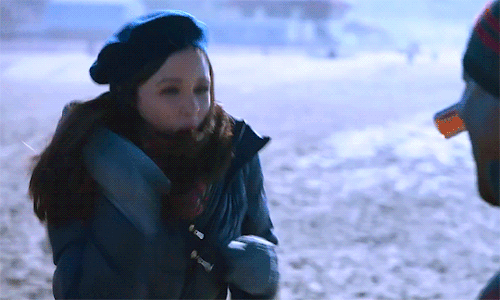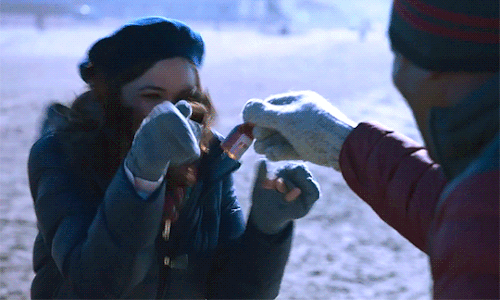Hey I Just Finished Oathbound And This Is A Cry For Help
hey I just finished oathbound and this is a cry for help
More Posts from Dismantledsmoothie and Others
Characters with inexplicably matching energies: kaz brekker (six of crows) and robin (teen titans)
Sokka: Alright, we need to get through this locked door. Zuko, give me your credit card.
Zuko: Here.
Sokka, pocketing it: Thanks. Toph, destroy the door.
Adam, scrying into a large mug of coffee: spirits, please show me what room my econ final is in


Updated at 4:05 p.m. ET
For the first time, doctors in the U.S. have used the powerful gene-editing technique CRISPR to try to treat a patient with a genetic disorder.
“It is just amazing how far things have come,” says Victoria Gray, 34, of Forest, Miss. “It is wonderful,” she told NPR in an exclusive interview after undergoing the landmark treatment for sickle cell disease.
Gray is the first patient ever to be publicly identified as being involved in a study testing the use of CRISPR for a genetic disease.
“I always had hoped that something will come along,” she says from a hospital bed at the Sarah Cannon Research Institute in Nashville, Tenn., where she received an infusion of billions of genetically modified cells. “It’s a good time to get healed.”
But it probably will take months, if not years, of careful monitoring of Gray and other patients before doctors know whether the treatment is safe and how well it might be helping patients.
In A 1st, Doctors In U.S. Use CRISPR Tool To Treat Patient With Genetic Disorder
Photos: Meredith Rizzo/NPR
Remember the Women Who Made #Apollo50th Possible
As the world celebrates the 50th anniversary of the historic Moon landing, we remember some of the women whose hard work and ingenuity made it possible. The women featured here represent just a small fraction of the enormous contributions made by women during the Apollo era.
Margaret Hamilton, Computer Programmer

Margaret Hamilton led the team that developed the building blocks of software engineering — a term that she coined herself. Her systems approach to the Apollo software development and insistence on rigorous testing was critical to the success of Apollo. In fact, the Apollo guidance software was so robust that no software bugs were found on any crewed Apollo missions, and it was adapted for use in Skylab, the Space Shuttle and the first digital fly-by-wire systems in aircraft.
In this photo, Hamilton stands next to a stack of Apollo Guidance Computer source code. As she noted, “There was no second chance. We all knew that.”
Katherine Johnson, Aerospace Technologist

As a very young girl, Katherine Johnson loved to count things. She counted everything, from the number of steps she took to get to the road to the number of forks and plates she washed when doing the dishes.
As an adult, Johnson became a “human computer” for the National Advisory Committee for Aeronautics, which in 1958, became NASA. Her calculations were crucial to syncing Apollo’s Lunar Lander with the Moon-orbiting Command and Service Module. “I went to work every day for 33 years happy. Never did I get up and say I don’t want to go to work.“
Judy Sullivan, Biomedical Engineer

This fabulous flip belongs to biomedical engineer Judy Sullivan, who monitored the vital signs of the Apollo 11 astronauts throughout their spaceflight training via small sensors attached to their bodies. On July 16, 1969, she was the only woman in the suit lab as the team helped Neil Armstrong suit up for launch.
Sullivan appeared on the game show “To Tell the Truth,” in which a celebrity panel had to guess which of the female contestants was a biomedical engineer. Her choice to wear a short, ruffled skirt stumped everyone and won her a $500 prize. In this photo, Sullivan monitors a console during a training exercise for the first lunar landing mission.
Billie Robertson, Mathematician

Billie Robertson, pictured here in 1972 running a real-time go-no-go simulation for the Apollo 17 mission, originally intended to become a math teacher. Instead, she worked with the Army Ballistic Missile Agency, which later became rolled into NASA. She created the manual for running computer models that were used to simulate launches for the Apollo, Skylab and Apollo Soyuz Test Project programs.
Robertson regularly visited local schools over the course of her career, empowering young women to pursue careers in STEM and aerospace.
Mary Jackson, Aeronautical Engineer

In 1958, Mary Jackson became NASA’s first African-American female engineer. Her engineering specialty was the extremely complex field of boundary layer effects on aerospace vehicles at supersonic speeds.
In the 1970s, Jackson helped the students at Hampton’s King Street Community center build their own wind tunnel and use it to conduct experiments. “We have to do something like this to get them interested in science,” she said for the local newspaper. “Sometimes they are not aware of the number of black scientists, and don’t even know of the career opportunities until it is too late.”
Ethel Heinecke Bauer, Aerospace Engineer

After watching the launch of Sputnik in October 1957, Ethel Heinecke Bauer changed her major to mathematics. Over her 32 years at NASA, she worked at two different centers in mathematics, aerospace engineering, development and more.
Bauer planned the lunar trajectories for the Apollo program including the ‘free return’ trajectory which allowed for a safe return in the event of a systems failure — a trajectory used on Apollo 13, as well as the first three Apollo flights to the Moon. In the above photo, Bauer works on trajectories with the help of an orbital model.
Follow Women@NASA for more stories like this one, and make sure to follow us on Tumblr for your regular dose of space: http://nasa.tumblr.com.
Adam Parrish: Just accidentally clicked "Sort by Price: High to Low" like some kind of child emperor.

Global warming: 🔥👹☠️
My grandma: omg blessed, #beachbabe
The modern day coming of age story starts with renouncing the things you loved as a kid for being for babies and ends with you learning to love them again
-
 otterlybeautiful liked this · 2 weeks ago
otterlybeautiful liked this · 2 weeks ago -
 kyaloupe liked this · 3 weeks ago
kyaloupe liked this · 3 weeks ago -
 backonmybullshit27 liked this · 4 weeks ago
backonmybullshit27 liked this · 4 weeks ago -
 lattebookworm liked this · 1 month ago
lattebookworm liked this · 1 month ago -
 oxymoron-in-progress liked this · 1 month ago
oxymoron-in-progress liked this · 1 month ago -
 chaoticfandomthings liked this · 1 month ago
chaoticfandomthings liked this · 1 month ago -
 nvrbloomagain liked this · 1 month ago
nvrbloomagain liked this · 1 month ago -
 brilud94 liked this · 1 month ago
brilud94 liked this · 1 month ago -
 in-your-eyes-alone liked this · 1 month ago
in-your-eyes-alone liked this · 1 month ago -
 certifiedsofty reblogged this · 1 month ago
certifiedsofty reblogged this · 1 month ago -
 ive-got-no-time-sorry liked this · 1 month ago
ive-got-no-time-sorry liked this · 1 month ago -
 tenselevens liked this · 1 month ago
tenselevens liked this · 1 month ago -
 alextarg liked this · 1 month ago
alextarg liked this · 1 month ago -
 i-suck-at-namess liked this · 1 month ago
i-suck-at-namess liked this · 1 month ago -
 angel-of-lilies liked this · 1 month ago
angel-of-lilies liked this · 1 month ago -
 laminated-entity reblogged this · 1 month ago
laminated-entity reblogged this · 1 month ago -
 scionlb liked this · 1 month ago
scionlb liked this · 1 month ago -
 just-a-queer-disaster liked this · 1 month ago
just-a-queer-disaster liked this · 1 month ago -
 currentlyily liked this · 1 month ago
currentlyily liked this · 1 month ago -
 proudchildlesscatlady liked this · 2 months ago
proudchildlesscatlady liked this · 2 months ago -
 waywardlampcookieturkey liked this · 2 months ago
waywardlampcookieturkey liked this · 2 months ago -
 aqueerincrisis liked this · 2 months ago
aqueerincrisis liked this · 2 months ago -
 itsfennikbitches reblogged this · 2 months ago
itsfennikbitches reblogged this · 2 months ago -
 itsfennikbitches liked this · 2 months ago
itsfennikbitches liked this · 2 months ago -
 worth-this-and-more liked this · 2 months ago
worth-this-and-more liked this · 2 months ago -
 shayminlucario07 liked this · 2 months ago
shayminlucario07 liked this · 2 months ago -
 poisonousflora liked this · 2 months ago
poisonousflora liked this · 2 months ago -
 laminated-entity liked this · 2 months ago
laminated-entity liked this · 2 months ago -
 brianakane reblogged this · 2 months ago
brianakane reblogged this · 2 months ago -
 thejudeduarte liked this · 2 months ago
thejudeduarte liked this · 2 months ago -
 nanamismoonchild liked this · 2 months ago
nanamismoonchild liked this · 2 months ago -
 brianna172 liked this · 2 months ago
brianna172 liked this · 2 months ago -
 iamconfusion-thankyou liked this · 2 months ago
iamconfusion-thankyou liked this · 2 months ago -
 kazoozie liked this · 2 months ago
kazoozie liked this · 2 months ago -
 mediumbloodcrafterscion liked this · 2 months ago
mediumbloodcrafterscion liked this · 2 months ago -
 booksareforever liked this · 2 months ago
booksareforever liked this · 2 months ago -
 moondivine22 liked this · 2 months ago
moondivine22 liked this · 2 months ago -
 nightismyhappyplace-blog liked this · 2 months ago
nightismyhappyplace-blog liked this · 2 months ago -
 amazingcreek liked this · 2 months ago
amazingcreek liked this · 2 months ago -
 bookwyrminspiration reblogged this · 2 months ago
bookwyrminspiration reblogged this · 2 months ago -
 starighost liked this · 2 months ago
starighost liked this · 2 months ago -
 dellslibary liked this · 2 months ago
dellslibary liked this · 2 months ago -
 marvinthegecko liked this · 2 months ago
marvinthegecko liked this · 2 months ago -
 andibecamethestars reblogged this · 2 months ago
andibecamethestars reblogged this · 2 months ago -
 andibecamethestars liked this · 2 months ago
andibecamethestars liked this · 2 months ago -
 phiadraws20 liked this · 2 months ago
phiadraws20 liked this · 2 months ago -
 disowned-mp3 liked this · 2 months ago
disowned-mp3 liked this · 2 months ago -
 haialiel liked this · 2 months ago
haialiel liked this · 2 months ago -
 somebodygetmesomecoffee reblogged this · 2 months ago
somebodygetmesomecoffee reblogged this · 2 months ago -
 dismantledsmoothie reblogged this · 2 months ago
dismantledsmoothie reblogged this · 2 months ago



